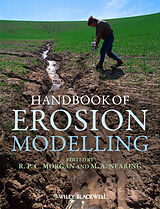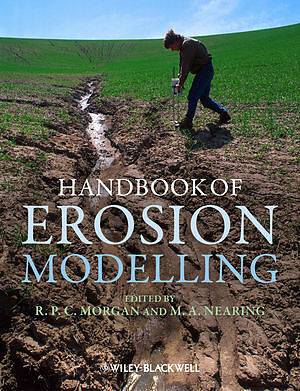Handbook of Erosion Modelling
Einband:
Fester Einband
EAN:
9781405190107
Untertitel:
Englisch
Genre:
Geowissenschaften
Autor:
Roy P. C. Morgan, Mark Nearing
Herausgeber:
Wiley
Auflage:
1. Auflage
Anzahl Seiten:
416
Erscheinungsdatum:
17.12.2010
ISBN:
978-1-4051-9010-7
The text will provide the erosion model user with the tools to evaluate different erosion models and select the most appropriate for a specific purpose compatible with the input data available. The first portion of the book describes how models are developed, and shows the advantages and limitations of each model.
Informationen zum Autor Roy Morgan is Emeritus Professor at Cranfield University, Bedfordshire, UK. His research interests cover soil erosion processes, the role of vegetation in soil erosion control and soil erosion modelling. He was involved in the development of EUROSEM (the European Soil Erosion Model). He is a Past-President and Honorary Member of the European Society for Soil Conservation and the author of Soil erosion and conservation (3rd edition, Blackwell 2005). Dr Mark Nearing has authored more than 200 scientific papers on the subject of soil erosion over the past 25 years. He is Past President and serves on the Board of Directors of the International Soil Conservation Organization and has organized and presented keynote presentations at numerous international meetings. Klappentext The movement of sediment and associated pollutants over the landscape and into water bodies is of increasing concern with respect to pollution control, prevention of muddy floods and environmental protection. In addition, the loss of soil on site has implications for declining agricultural productivity, loss of biodiversity and decreased amenity and landscape value. The fate of sediment and the conservation of soil are important issues for land managers and decision-makers. In developing appropriate policies and solutions, managers and researchers are making greater use of erosion models to characterise the processes of erosion and their interaction with the landscape.A study of erosion requires one to think in terms of microseconds to understand the mechanics of impact of a single raindrop on a soil surface, while landscapes form over periods of thousands of years. These processes operate on scales of millimetres for single raindrops to mega-metres for continents. Erosion modelling thus covers quite a lot of ground. This book introduces the conceptual and mathematical frameworks used to formulate models of soil erosion and uses case studies to show how models are applied to a variety of purposes at a range of spatial and temporal scales. The aim is to provide land managers and others with the tools required to select a model appropriate to the type and scale of erosion problem, to show what users can expect in terms of accuracy of model predictions and to provide an appreciation of both the advantages and limitations of models. Problems covered include those arising from agriculture, the construction industry, pollution and climatic change and range in scale from farms to small and large catchments. The book will also be useful to students and research scientists as an up-to-date review of the state-of-art of erosion modelling and, through a knowledge of how models are used in practice, in highlighting the gaps in knowledge that need to be filled in order to develop even better models. Zusammenfassung The text will provide the erosion model user with the tools to evaluate different erosion models and select the most appropriate for a specific purpose compatible with the input data available. The first portion of the book describes how models are developed, and shows the advantages and limitations of each model. Inhaltsverzeichnis 1. Introduction2. Model development: a user's perspective3. Calibration of erosion models4. Dealing with uncertainty in erosion model predictions5. A case study of model uncertainty: an evaluation of the dynamic capability of EUROSEM using GLUE6. Scaling soil-erosion models in space and time7. Misapplications and misconceptions of erosion models8. Universal Soil Loss Equation and Revised Universal Soil Loss Equation9. Application of WEPP to sustainable management of a small catchment in south-west Missouri, U.S.A., under present land use and with climatic change10. Predicting soil loss and runoff from forest roads and seasonal cropping systems in Brazil using WEPP11. Use of GUEST technology to parameterise a physically-ba...
Autorentext
Roy Morgan is Emeritus Professor at Cranfield University, Bedfordshire, UK. His research interests cover soil erosion processes, the role of vegetation in soil erosion control and soil erosion modelling. He was involved in the development of EUROSEM (the European Soil Erosion Model). He is a Past-President and Honorary Member of the European Society for Soil Conservation and the author of Soil erosion and conservation (3rd edition, Blackwell 2005). Dr Mark Nearing has authored more than 200 scientific papers on the subject of soil erosion over the past 25 years. He is Past President and serves on the Board of Directors of the International Soil Conservation Organization and has organized and presented keynote presentations at numerous international meetings.
Klappentext
The movement of sediment and associated pollutants over the landscape and into water bodies is of increasing concern with respect to pollution control, prevention of muddy floods and environmental protection. In addition, the loss of soil on site has implications for declining agricultural productivity, loss of biodiversity and decreased amenity and landscape value. The fate of sediment and the conservation of soil are important issues for land managers and decision-makers. In developing appropriate policies and solutions, managers and researchers are making greater use of erosion models to characterise the processes of erosion and their interaction with the landscape. A study of erosion requires one to think in terms of microseconds to understand the mechanics of impact of a single raindrop on a soil surface, while landscapes form over periods of thousands of years. These processes operate on scales of millimetres for single raindrops to mega-metres for continents. Erosion modelling thus covers quite a lot of ground. This book introduces the conceptual and mathematical frameworks used to formulate models of soil erosion and uses case studies to show how models are applied to a variety of purposes at a range of spatial and temporal scales. The aim is to provide land managers and others with the tools required to select a model appropriate to the type and scale of erosion problem, to show what users can expect in terms of accuracy of model predictions and to provide an appreciation of both the advantages and limitations of models. Problems covered include those arising from agriculture, the construction industry, pollution and climatic change and range in scale from farms to small and large catchments. The book will also be useful to students and research scientists as an up-to-date review of the state-of-art of erosion modelling and, through a knowledge of how models are used in practice, in highlighting the gaps in knowledge that need to be filled in order to develop even better models.
Inhalt
1. Introduction 2. Model development: a user's perspective 3. Calibration of erosion models 4. Dealing with uncertainty in erosion model predictions 5. A case study of model uncertainty: an evaluation of the dynamic capability of EUROSEM using GLUE 6. Scaling soil-erosion models in space and time 7. Misapplications and misconceptions of erosion models 8. Universal Soil Loss Equation and Revised Universal Soil Loss Equation 9. Application of WEPP to sustainable management of a small catchment in south-west Missouri, U.S.A., under present land use and with climatic change 10. Predicting soil loss and runoff from forest roads and seasonal cropping systems in Brazil using WEPP 11. Use of GUEST technology to parameterise a physically-based model for assessing soil erodibility and evaluating conservation practices in tropical…

Leider konnten wir für diesen Artikel keine Preise ermitteln ...
billigbuch.ch sucht jetzt für Sie die besten Angebote ...
Die aktuellen Verkaufspreise von 6 Onlineshops werden in Realtime abgefragt.
Sie können das gewünschte Produkt anschliessend direkt beim Anbieter Ihrer Wahl bestellen.
Loading...
Die aktuellen Verkaufspreise von 6 Onlineshops werden in Realtime abgefragt.
Sie können das gewünschte Produkt anschliessend direkt beim Anbieter Ihrer Wahl bestellen.
| # | Onlineshop | Preis CHF | Versand CHF | Total CHF | ||
|---|---|---|---|---|---|---|
| 1 | Seller | 0.00 | 0.00 | 0.00 |
